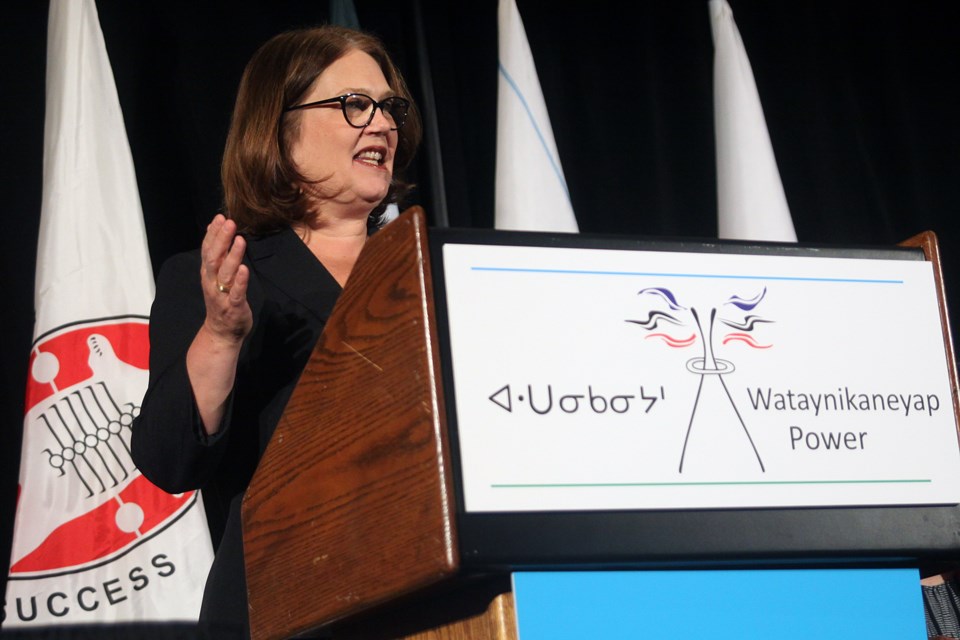THUNDER BAY – Sixteen remote First Nations communities in Northwestern Ontario are on track to be hooked up to the provincial energy grid within the next five years in what is described as the largest First Nations power connection project in Canada.
Indigenous Services Minister Jane Philpott announced $1.6 billion in federal funding to Wataynikaneyap Power, a majority owned company by 22 First Nations communities to bring power lines into the far north and end reliance on diesel.
The first phase of the project, which could begin construction as early as next year, would upgrade current transmission infrastructure from Ignace to Pickle Lake with a targeted completion of 2020. The second stage would extend lines north of Pickle Lake and Red Lake reach the 16 communities, with in-service dates beginning in 2021 and all hooked up by 2023.
Philpott said the initiative, which will reach more than 14,000 people, is the most expansive Indigenous-led transmission project in Canada’s history.
“We cannot overemphasize the importance of this, not just for the 16 communities but for all of us as Canadians,” Philpott said.
“I hear so many chiefs talk about what this will mean to the young people who will be able to rely on power. Most Canadian teenagers can’t imagine that you couldn’t have reliable power every single day of the year but the Canadian teenagers in the north have known what it is like to know that sometimes you may go days without power.”
Utilizing the provincial energy grid is projected to result in savings of $1 billion over 40 years compared to using diesel, with the environmental impact equivalent to removing 35,000 vehicles from the road.
Wataynikaneyap Power chief executive officer Margaret Kenequanash, who said efforts to connect the communities to the grid date back more than 25 years, said the announcement symbolizes the ability to move forward.
“The line that lights up the north, it’s going to benefit not only First Nations but also Ontario and Canada in terms of whatever economic prosperity and opportunities present themselves,” Kenequanash said.
“We have to be visionaries in this project. This is a sliver of what our First Nations people can do in exercising that jurisdiction they have, that inherent right to be able to be part of that economic thrust and be part of the wealth generation and be part of the economy of Canada.”
The project is expected to create nearly 770 jobs, 220 of which would be based in Northwestern Ontario.
Ontario Premier Kathleen Wynne described the announcement as a major milestone for an incredibly important project, one that sends a clear message.
“It says that you don’t have to leave your community behind to find opportunity,” Wynne said. “It says you can develop a career in engineering, a skilled trade or as a senior manager in a major construction project because that’s happening in your own region.”
Having secure and reliable power is the first step in developing solutions to other challenges such as inadequate housing, unsafe drinking water and enhancing the capability of schools and nursing stations in these communities, said Nishnawbe Aski Nation Grand Chief Alvin Fiddler.
“The work is not done. This is only the start. We want to begin to fully develop our communities,” Fiddler said. “We need roads. We need the proper infrastructure to support the other projects that will be coming.”
Philpott said the establishment of corridors for the power lines could likely lead to eventual future infrastructure expansion.
“We now have corridors that are being opened up, transmission towers and power towers that are moving along the lines to these remote communities. It’s foreseeable that broadband could at some point in the future be added in here,” Philpott said.
Communities to be connected by the Wataynikaneyap Power project:
- Bearskin Lake First Nation
- Deer Lake First Nation
- Kasabonika Lake First Nation
- Keewaywin First Nation
- Kingfisher First Nation
- Kitchenuhmaykoosib Inninuwug First Nation
- Muskrat Dam Lake First Nation
- North Caribou Lake First Nation
- North Spirit Lake First Nation
- Pikangikum First Nation (announced August 2017)
- Poplar Hill First Nation
- Sachigo Lake First Nation
- Sandy Lake First Nation
- Wapekeka First Nation
- Wawakapewin First Nation
- Wunnumin First Nation
